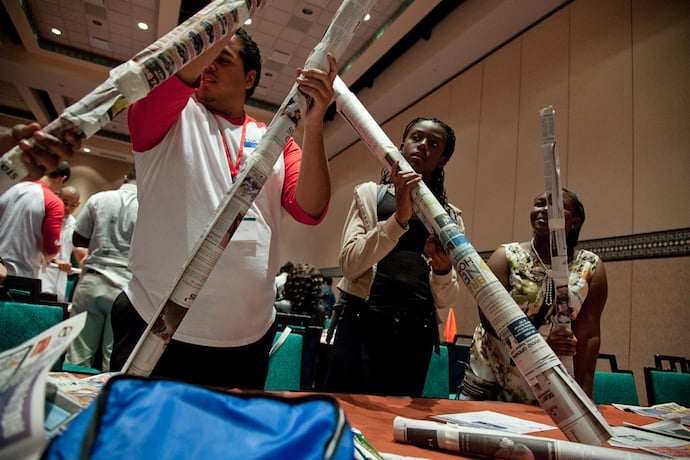During the first lesson of the year, I give students only two rules: you have to make use of all the materials provided to you, and you can have as much masking tape as you need. At this point the 3-person groups jump into action, although I know that many will not heed my advice about the double-edged sword that is masking tape.
Despite primarily teaching programming and robotics, I begin each year with an engineering challenge. In this case, I ask students to build a freestanding office supply tower out of paper, index cards, wire hangers, and tape. From my observations during these challenges, I learn an incredible amount about the soft skills students bring to the classroom.
Some students barrel through a first failed attempt with grit and a steely-eyed resolve. Others have difficulty listening to teammates and invest way to long in faulty designs. However, by the end they all come to realize that, despite its abundance, masking tape is heavy. As their towers list to the side burdened with tape, they at least have a better understanding that gravity is a force to be respected.
Very simply, these lessons are a quick diagnostic for me to understand where my students are cognitively. However, I have come to see these lessons as more than an enjoyable on-ramp to the year. Lessons that incorporate kinesthetic learning are an essential ingredient in the STEM classroom because they reach students that traditional coding courses can repel.
Kinesthetic learners learn while doing. They can be turned off or distracted by long sessions at a computer screen. It is harder for them to codify and retain information when it is presented visually or spoken orally. Due to these barriers, they can begin to believe that technology is “not their thing” or they aren’t “computer smart”. The constructivist educator Samuel Pappert, I assert, would have disagreed with them.
An MIT professor and co-founder of the MIT Media Lab, Pappert believed that students learn best when they are actively building things. He created the LOGO language and the first iteration of turtle programming – a roving, drawing turtle robot. As a Computer Science teacher, I find I am continually returning to Pappert’s teaching philosophy.
Pappert’s encouragement of making and doing as a part of computing is an idea that has inspired much of the maker movement, and continues to influence educators today. I keep a copy of his article “Twenty Things to do with a Computer” in my room at all times, consider it a touchstone, and return to it frequently.
In a recent lesson on algorithms and route finding, I had a moment of inspiration to grab some kinesthetic learners. I taped small Xs one meter apart on the carpets around the intersecting hallways of our school. Route-finding algorithms can be quite complicated to implement, but are simple in theory. Students were given starting points and destinations and had to find the optimal route by numbering the steps working backwards from their destination.
During the lesson I watched as students made assumptions about the fastest route, and while some of their assumptions were correct, some found otherwise. In the end, I saw greater numbers of engaged students and they digested a complicated topic rather quickly. Moreover, the lesson became an instructive model for algorithms and how they work.
Some days my classes look more like drama warm-ups as students are in my room acting out how logic gates work. Other days it can look like a science lab as they observe a jumping student to better program gravity in game design. As much as possible, I try to pair kinesthetic activity with coding concepts. The convenience of the internet and modern computing has reduced the physicality of programming – to the detriment of some students. Getting students literally walking in the footsteps of innovators like Samuel Pappert and Admiral Grace Hopper in my mind helps keep STEM inclusive. Furthermore, as a teacher who is trying to catch all the diverse learners out there, I find it is essential to what I do.
Learn More
About kinesthetic learning
https://www.education.com/magazine/article/kinesthetic_learner/
https://www.learningstyles.org/styles/kinesthetic.html
16 characteristics of kinesthetic and tactile learners
Engaging students in STEM
https://www.labster.com/blog/3-ways-to-make-stem-education-more-engaging/
https://www.edutopia.org/blog/stem-engagement-maker-movement-annmarie-thomas

